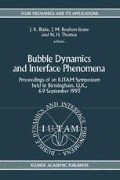Abstract
Intraocular microsurgery relies on plasma generation with subsequent shock wave emission and cavitation bubble formation. To asses the potentials of photodisruption with picosecond pulses in comparison to the clinical techniques presently used, the shock wave characteristics and the bubble expansion after optical breakdown with picosecond (30 ps) and nanosecond (6 ns) Nd:YAG laser pulses were investigated by time-resolved photography. Frequency doubled light from the laser pulses was optically delayed and used as the illumination source for photography.The shock wave position and bubble wall position were determined as a function of time. From the slope of the r(t) curves, the shock wave and bubble wall velocities were derived, and then the shock wave pressure p(r) was calculated from the shock velocity. The optical breakdown threshold was 15 μJ for the ps-pulses and 200 μJ for the ns-pulses. The initial shock pressures were 13 kbar and 17 kbar after ps-pulses with an energy of 50 μJ and 1 mJ, respectively, 24 kbar after a 1 mJ ns-pulse, and 71 kbar after a 10 mJ ns-pulse. After formation of the shock front, the shock pressure decayed approximately proportional to 1/r 2. The maximum expansion velocity of the cavitation bubble was 390 m/s after a 50 μJ ps-pulse, 780 m/s after a 1 mJ ps-pulse, 1850 m/s after a 1 mJ ns-pulse, and 2500 m/s after a 10 mJ ns-pulse The lower threshold for plasma formation with ps-pulses allows a reduction of the laser pulse energy which is accompanied by a considerable decrease of the disruptive shock wave and cavitation effects and an increase of the surgical precision.
Access this chapter
Tax calculation will be finalised at checkout
Purchases are for personal use only
Preview
Unable to display preview. Download preview PDF.
References
R.F. Steinert and C.A. Puliafito, “The Nd:YAG Laser in Ophthalmology” ,Philadelphia, PA, Saunders 1985.
F. Fankhauser and S. Kwasniewska, “Neodymium:yttrium-aluminium-garnet laser”, In “Ophthalmic Lasers” ,Third Edition, F.A. L’Esperance, editor. St. Louis, MO, Mosby, pp. 781–886, 1989.
A. Vogel, P. Schweiger, A. Frieser, M.N. Asiyo and R. Birngruber, “Intraocular Nd:YAG laser surgery: light-tissue interaction, damage range, and reduction of collateral effects”, IEEE J. Quant Electr. Vol. 26, pp. 2240–2260, 1990.
V.P. Gabel, L. Neubauer, H. Zink and R. Birngruber, “Ocular side effects following neodymium: YAG laser irradiation”, Int. Ophthalmol. Clin. Vol. 25, pp. 137–149, 1985.
J.G. Fujimoto, W.Z. Lin, E.P. Ippen, C.A. Puliafito and R.F. Steinert, “Time-resolved studies of Nd:YAG laser-induced breakdown”, Invest. Ophthalmol. Vis. Sci. Vol. 26, pp. 1771–1777, 1985.
A. Vogel, W. Hentschel, J. Holzfuss and W. Lauterborn, “Oavitation bubble dynamics and acoustic transient generation in ocular surgery with pulsed neodymium:YAG lasers”, Ophthalmol.Vol 93 pp. 1259 1269, 1986.
M.R.O. Capon and J. Mellerio, “Nd:YAG lasers: plasma characteristics and damage mechanisms”,Lasers Ophthalmol. Vol. 1, pp. 95–106, 1986.
J. Mellerio, M. Capon and F. Docchio, “Nd:YAG lasers: a potential hazard from cavitation bubble behaviour in anterior chamber procedures?”, Lasers Ophthalmol. Vol. 1, pp. 185–190, 1987.
F. Docchio, C.A. Sacchi and J. Marshall, “Experimental investigation of optical breakdown thresholds in ocular media under single pulse irradiation with different pulse durations”, Lasers Ophthalmol. Vol. 1, pp. 83–93, 1986.
F. Docchio and C.A. Sacchi, “Shielding properties of laser-produced plasmas in ocular media irradiated by single Nd:YAG pulses of different duration”, Invest. Ophthalmol. Vis. Sci. Vol. 29, pp. 437–443, 1988.
B. Zysset, G. Fujimoto and T.F. Deutsch, “Time-resolved measurements of picosecond optical breakdown”, Áppl. Phys. B Vol. 48, pp. 139–147, 1989.
B. Zysset, J.G. Fujimoto, C.A. Puliafito, R. Birngruber and T.F. Deutsch, “Picosecond optical breakdown: Tissue effects and reduction of collateral damage”, Lasers Surgery Medicine Vol. 9, pp. 193–204, 1989.
A.G. Doukas, A.D. Zweig, J.K. Frisoli, R. Birngruber and T. Deutsch, “Non-invasive determinati on of shock wave pressure generated by optical breakdown”, Appl. Phys. B Vol. 53, pp. 237–245, 1991.
A. Vogel, W. Lauterborn and R. Timm, “Optical and acoustic investigations of the dynamics of laser-produced cavitation bubbles near a solid boundary”, J. Fluid. Mech. Vol. 206 ,pp. 299–338 ,1989.
C.E. Bell and J.A. Landt, “Laser-induced high-pressure shock waves in water”, Appl. Phys. Lett. Vol. 10, PP. 46–48, 1967.
M.H. Rice and J.M. Walsh, “Equation of state of water to 250 kilobars”, J. Chem. Phys. Vol. 26, pp. 824–830, 1957.
G.E. Duvall and G.R. Fowles, “Shock waves”. In “High Pressure Physics and Chemistry”, R.S. Bradley, editor. New York, Academic Press, 1963.
R.H. Cole, “Underwater Explosions” ,Princeton, NJ, Princeton University Press 1948.
A. Vogel, S. Busch, M. Asiyo-Vogel, “Time-resolved measurements of shock wave emission and cavitation bubble generation in intraocular laser surgery with ps-and ns-pulses and related tissue effects”, in: Ophthalmic Technologies III, SPIE Proc. Vol. 1877, J.M. Parel and Q. Ren, editors, pp. 312–322, 1993.
P. Harris, H.N. Presles, “The shock induced electrical polarization of water”, J. Chem. Phys. Vol. 74, pp 6864–6866, 1981.
Author information
Authors and Affiliations
Editor information
Editors and Affiliations
Rights and permissions
Copyright information
© 1994 Springer Science+Business Media Dordrecht
About this paper
Cite this paper
Vogel, A., Busch, S. (1994). Time-resolved measurements of shock-wave emission and cavitation-bubble generation in intraocular laser surgery with ps- and ns-pulses. In: Blake, J.R., Boulton-Stone, J.M., Thomas, N.H. (eds) Bubble Dynamics and Interface Phenomena. Fluid Mechanics and Its Applications, vol 23. Springer, Dordrecht. https://doi.org/10.1007/978-94-011-0938-3_10
Download citation
DOI: https://doi.org/10.1007/978-94-011-0938-3_10
Publisher Name: Springer, Dordrecht
Print ISBN: 978-94-010-4404-2
Online ISBN: 978-94-011-0938-3
eBook Packages: Springer Book Archive

